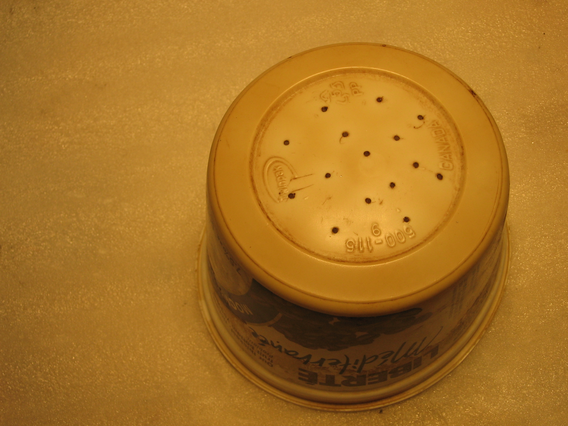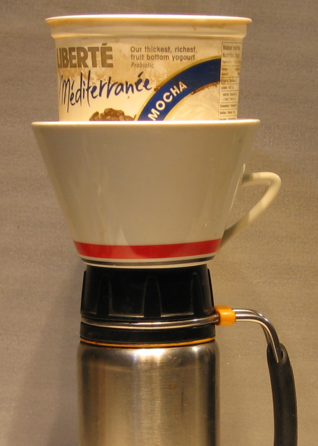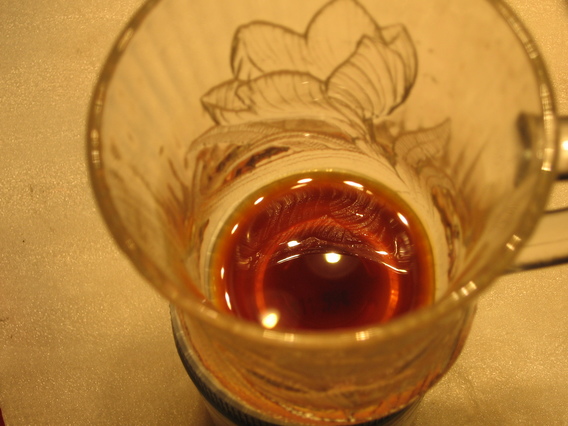Coffee Showerhead
Description
The goal was to produce a cup of coffee that rivals that produced by a skilled barista doing a pour over. That may have been achieved and interesting stuff popped up.
Details
A skilled barista will use a goose necked kettle to evenly distribute hot water over the coffee grounds in a coffee dripper.
A high end coffee maker will distribute the water using a shower head. link 1
My idea was to produce a shower head that could be used with a relatively inexpensive coffee dripper like the Melitta for instance.
The shower head is just a yogurt tub with holes drilled in the bottom.

In the picture below, the dripper sits an a travel mug. The dripper contains a paper filter filled with the correct amount of coffee. The shower head sits in the dripper. Because of the conical shape of the dripper, the bottom of the shower head sits about half an inch above the coffee grounds.

All the hot water is poured into the shower head at once. The holes are intended to control the distribution and flow rate of the water through the ground coffee.
Results
Using the same kind of coffee with the same grind and the same kind of filter and the same amount of water, the home brew shower head produced coffee with much more body and much more intense flavor than our, expensive highly touted drip coffee maker. The difference was not at all subtle.
After brewing, the bottom of the shower head is covered with coffee grounds. That means the space below the shower head was completely filled for at least some of the time by water and grounds.
Measuring coffee solids
How much solid material ends up in the coffee is a big deal. Coffee people talk about measuring Total Dissolved Solids (TDS) using a refractometer. That's a device that measures how light bends as it passes through a liquid. That surprised me because Total Dissolved Solids are more commonly measured using electrical conductivity. link 2
I wondered if TDS could be measured using something like a Secchi disk which measures the transmission of light through water. My version was a white jar lid with a price tag affixed.

A glass cup was set on top of the Secchi Disk and filled with coffee until the the writing on the price tag was just barely visible.

The amount of coffee in the cup was measured by weighing the cup.
| device | weight |
|---|
| empty cup | 333.5 gm |
homebrew
shower head | 349.0 - 333.5 = 15.5 gm |
expensive
coffee maker | 380.0 - 333.5 = 46.5 gm |
That's dramatic. The coffee made with the homebrew shower head was about three times as good at blocking light as was that made in the expensive brewer. That implies a lot more solids.
I decided to see if the results could be confirmed by measuring the conductivity of the liquids with an ohmmeter. (Conductivity is just the inverse of resistance after all.) The measurements were done by filling the cup with 4 cm of liquid with the ohmmeter probes separated by 6 cm.
| fluid | ohms | mhos |
|---|
| tap water | 170 kOhms | 6 uMhos |
| homebrew | 44 kOhms | 20 uMhos |
| expensive | 47 kOhms | 20 uMhos |
It turns out that an ohmmeter isn't that good at measuring the conductivity of liquids (see link 2 above). In that light, the two coffees were close enough to having the same conductivity that the difference is moot. That implies that they have about the same total dissolved solids.
Discussion
Link 2 above is extremely enlightening. A Socchi disk (or spectroscopy) measures the transmission of light through water. That determines the Total Suspended Solids (TSS). Electrical conductivity measures Total Dissolved Solids (TDS). They're not the same.
When they talk about coffee extraction, I suspect that they don't distinguish between suspended and dissolved solids.



